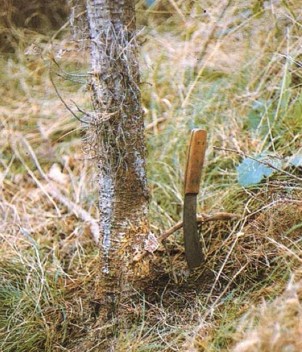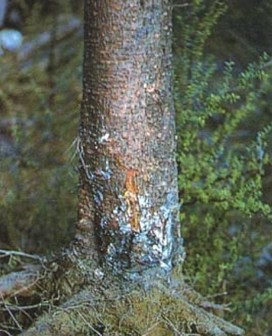PESTS AND DISEASES OF FORESTRY IN NEW ZEALAND
Peniophora root and stem canker
Scion is the leading provider of forest-related knowledge in New Zealand
Formerly known as the Forest Research Institute, Scion has been a leader in research relating to forest health for over 50 years. The Rotorua-based Crown Research Institute continues to provide science that will protect all forests from damage caused by insect pests, pathogens and weeds. The information presented below arises from these research activities.
Forest Pathology in New Zealand No. 3
Peniophora root and stem canker
Based on M. Dick (1983), revised 2003, updated 2009.
Causal organism
Gloeopeniophorella sacrata (G. Cunn.) Hjortstam & Ryvarden
Syn: Peniophora sacrata G. Cunn.; Dextrinocystidium sacratum (G. Cunn.) Sheng H. Wu;
Gloeocystidiellum sacratum (G. Cunn.) Stalpers & P.K. Buchanan
This disease was originally called “Glenbervie root and stem canker” after the forest where it was first found.

Fig. 1 - Direct contact between a branch of broom infected with Gloeopeniophorella sacrata and an uninfected stem of Pinus radiata has resulted in the transfer of the disease to the tree. Note the fungal pad which has developed at the point of contact, and the occurrence of resin bleeding.
Type of injury
Gloeopeniophorella sacrata either attacks and progressively destroys the roots of a host plant, or directly invades its stem. Infected trees usually die; group mortality often occurs in young plantations.
Diagnostic features
- Dead vegetation (scrub plants or Pinus radiata) grouped in roughly circular patches (Fig. 2).
- A girdling canker either at the root collar or on the stem, with copious resin bleeding (Fig. 3).
- Tough, white to yellowish-white pads of fungal tissue on bark at the site of the canker. Stems of the scrub host may still be attached to the fungal pad (Fig. 1).
- Progressive yellowing and reddening of needles, starting at the tips, and premature casting. New needle growth much reduced.
Hosts
Gloeopeniophorella sacrata has been recorded on many exotic and native host plants. It is also known as a decay organism of dead wood.
Parasitic attack (host living):
Trees: Acacia melanoxylon, Chamaecyparis lawsoniana, Cornus capitata, Eucalyptus botryoides, E. delegatensis, E. nitens, E. olsenii, E. ovata, E. saligna, Pinus caribaea, P. contorta, P. ellottii, P. muricata, P. nigra, P. nigra ssp. nigra, P. palustris, P. patula, P. pinaster, P. radiata, P. taeda, Podocarpus totara, Prumnopitys ferruginea, Pseudopanax arboreus, Pseudotsuga menziesii, Thuja plicata.
Shrubs: Brachyglottis repanda, Coprosma grandifolia, Hakea sericea, Hebe sp. , Leptospermum scoparium, Pomaderris kumeraho, P. amoena, Ulex europaeus .
Non-parasitic (host dead):
Trees: Acacia dealbata, Beilschmiedia tawa, Casuarina sp., Cedrus deodara, Cupressus macrocarpa, C. lusitanica, Fuchsia excorticata, Macropiper excelsum, Malus sp., Melicytus ramiflorus, Meryta sinclairii, Populus sp., Quintinia serrata, Schefflera digitata, Ulmus sp., Weinmannia racemosa.
Shrubs: Ageratina adenophora (syn. Eupatorium adenophorum), Coprosma repens, C. robusta, Erica sp., Kunzea ericoides, Leucopogon fasciculatus, Muehlenbeckia australis, Passiflora tetranda, Pseudopanax crassifolius, Pteridium esculentum, Ripogonum scandens, Rubus australis, Rubus fruticosus agg., Tecomaria capensis.
Fig. 2 - Dead and dying trees at the margin of an infected patch of Pinus radiata .

Fig. 3 - Resin bleeding at root collar level - a characteristic feature of a tree infected by Gloeopeniophorella sacrata.
Distribution
The fungus, which was first recorded in New Zealand in 1951, is found in most parts of the country north of Otago. It is most prevalent in Northland plantations where it was first found. In the South Island, some forests in the Nelson region have the greatest incidence of mortality caused by this disease.
Disease development
The ideal habitat for development of this disease appears to be country carrying heavy manuka scrub in areas where warm soil and air temperatures are maintained for the greater part of the year. Infection is established when a root, or part of the stem of the new host come into contact with infected tissues of scrub plants. These scrub plants become attached to the host by a tough, white, fungal pad. As the disease progresses, a girdling canker is produced at root collar level, or on the stem, and copious resin bleeding occurs. Following the death of the host, cream to buff-coloured pads of fungal tissue form outside the bark and the woody tissue rots, becoming white and spongy.
In young exotic pine plantations the most distinctive feature of the disease is the way roughly circular patches of trees become infected and die: these patches increase in diameter as the stand ages. Trees die slowly over a period of 3-4 years. The first signs of the decline are a progressive yellowing and reddening of the needles, starting from the tips, and premature casting of the needles. The youngest needles are the last to show these symptoms and new needle growth is much reduced. In very young or unthrifty trees death can occur more quickly, so these symptoms of decline may not be evident.
The spread of the disease is arrested at the time of canopy closure. By this stage in stand development the scrub regrowth, which occurs in most areas where this disease occurs, has been entirely suppressed by the lack of light, so contact between infected scrub species and growing trees is effectively eliminated. Some mortality may still occur after canopy closure because infected trees continue to decline slowly.
Although fruiting bodies are produced on the stems of dead manuka, they are rarely found on the exotic pine species killed by the disease, and spore dissemination is thought to be unimportant in the spread of the disease.
Economic importance
In most parts of New Zealand the incidence of the disease is limited, and the fungus is not considered to be of significant economic importance. However, in areas where the disease is widespread (such as some Northland forests in heavy manuka scrub country), scattered groups of trees, amounting to 10-20% of those planted, have been killed within 10 years of establishment. Little further mortality has occurred thereafter and no new areas of infection have been observed in established stands. Although the impact of the disease in subsequent crops of pine trees is unknown, the fungus is known to remain virulent within a patch for at least 30 years.
Control
Not considered necessary.
Bibliography
Dick, M. 1983: Peniophora root and stem canker. New Zealand Forest Service, Forest Pathology in New Zealand No. 3.
Gilmour, J.W. 1959: A root and stem canker of exotic conifers in New Zealand. New Zealand Forest Service, Technical Paper No. 25.
Gilmour, J.W. 1966: The pathology of forest trees in New Zealand: the fungal, bacterial and algal pathogens. New Zealand Forest Service, Technical Paper No. 48.
Ridley, G.S.; Dick, M.A. 2001: An introduction to the diseases of forest and amenity trees in New Zealand. Forest Research Bulletin 220. New Zealand Forest Research Institute,
Rotorua 110p.
Compiled: 1993; revised J.F. Gardner, M.A. Dick 2003; updated 2009.
This information is intended for general interest only. It is not intended to be a substitute for specific specialist advice on any matter and should not be relied on for that purpose. Scion will not be liable for any direct, indirect, incidental, special, consequential or exemplary damages, loss of profits, or any other intangible losses that result from using the information provided on this site.
(Scion is the trading name of the New Zealand Forest Research Institute Limited.)

 Farm Forestry New Zealand
Farm Forestry New Zealand

